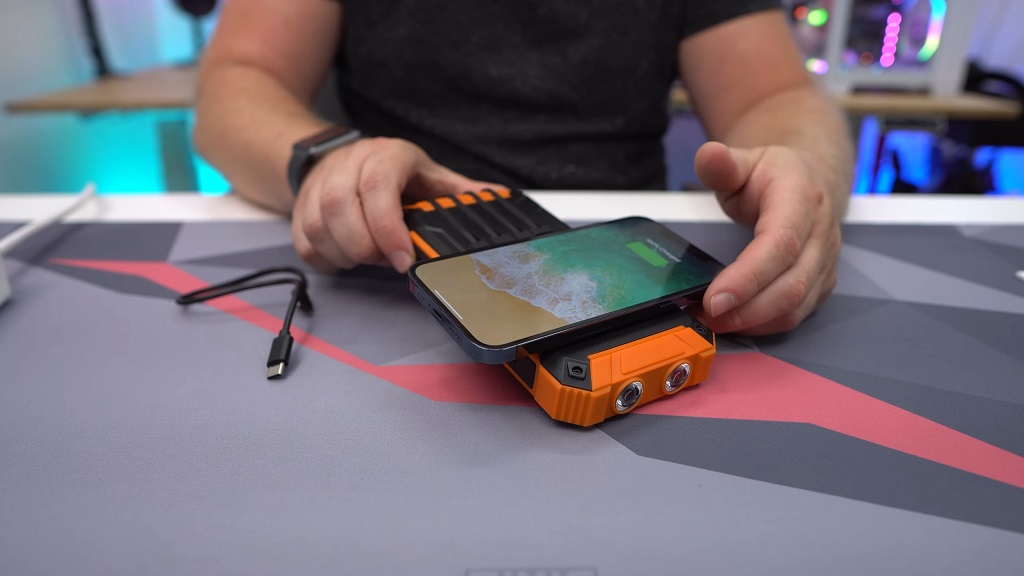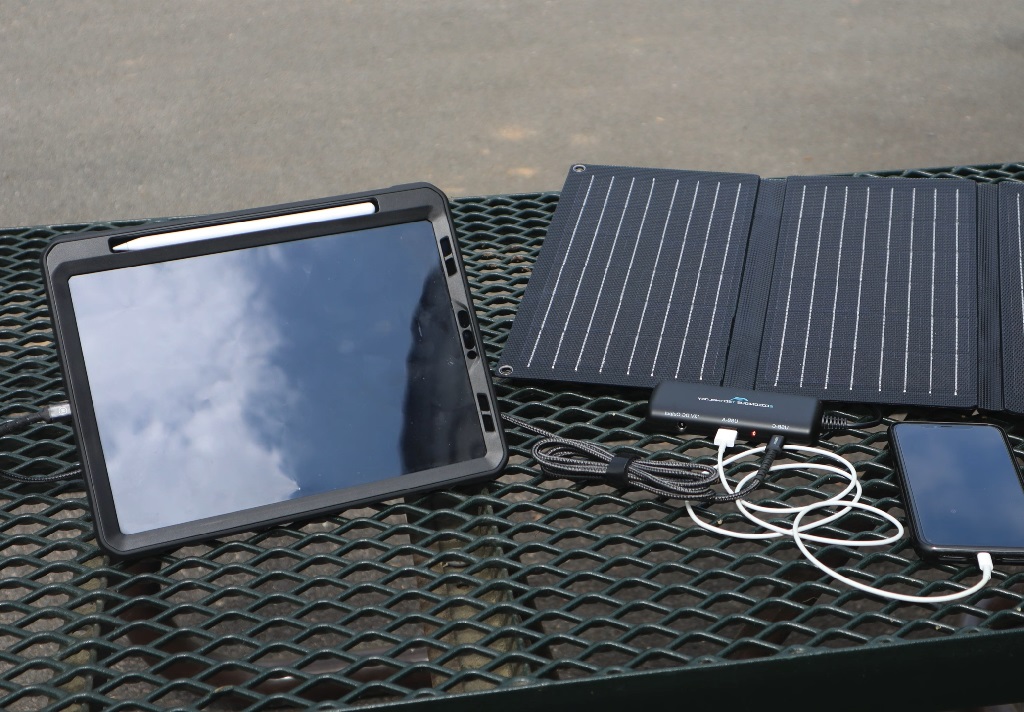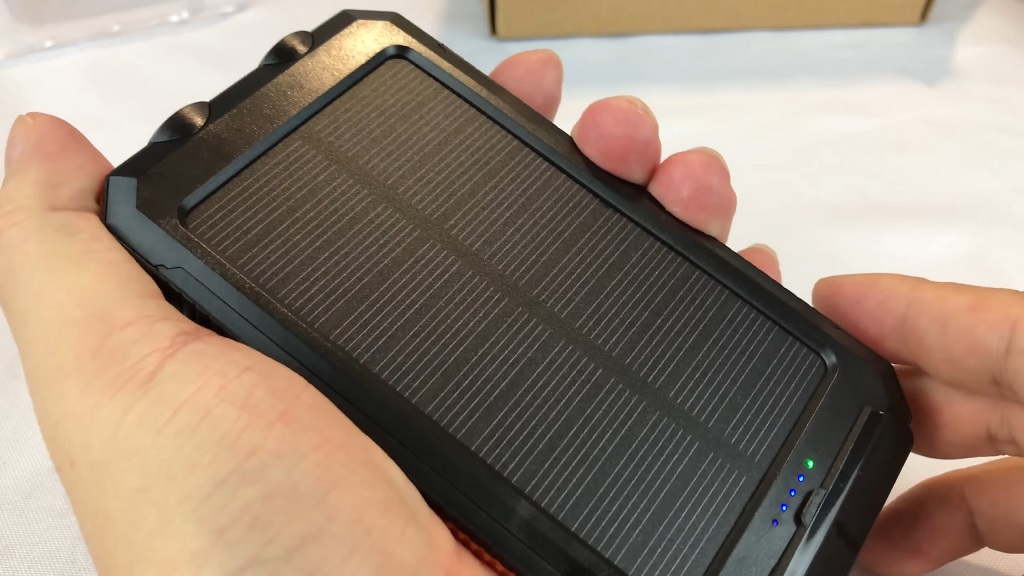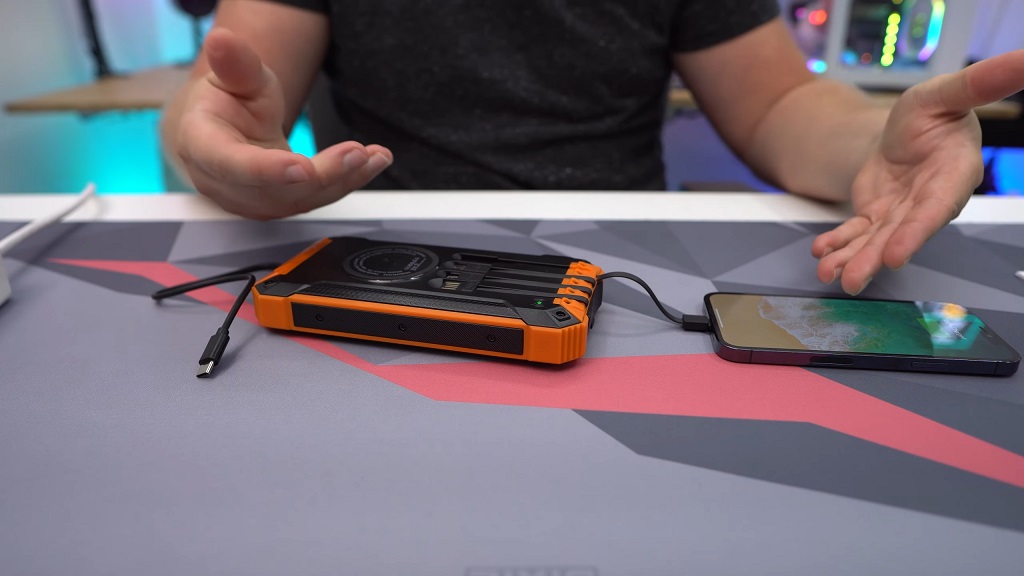Solar phone chargers offer an alternative power source using the sun’s energy.
These devices are especially useful during camping trips, emergencies, and remote travel, where access to electricity is limited.
Setting realistic expectations about charging times helps avoid frustration and allows for proper trip planning.
While convenient in outdoor conditions, they are typically not designed to deliver fast power delivery like traditional wall chargers.
How Solar Phone Chargers Work

Solar phone chargers operate through photovoltaic (PV) cells, which absorb sunlight and convert it into direct current (DC) electricity.
These cells are typically made using semiconductor materials like silicon, which respond to sunlight by releasing electrons, generating a usable electrical current.
Once electricity is generated, it often flows into an internal lithium-ion (Li-Ion) or lithium-polymer (Li-Po) battery.
Power banks with this feature act as buffers, making energy available on demand rather than only during direct sunlight exposure.
Some chargers also support direct charging, where the power flows immediately to the connected device without battery storage. This method can be unreliable in environments with inconsistent sunlight, such as shaded areas or during intermittent cloud cover.
Devices may start and stop charging, which could lead to longer charging times or even battery health issues over time.
A solar phone charger typically contains the following components:
- Solar Panel: Captures sunlight and converts it into electrical energy through PV cells
- Charge Controller: Manages the voltage and current to protect internal batteries and devices from overcharging or power fluctuations
- Battery: Stores solar energy for later use, enabling device charging when sunlight is unavailable
- Output Ports: USB, micro-USB, or USB-C ports that allow the user to plug in phones, tablets, cameras, or other small electronics
Key Factors Affecting Charging Time
The charging performance of solar phone chargers varies widely based on several influencing elements.
It’s not just about having sunlight; device battery size, panel wattage, panel efficiency, and environmental conditions all come into play.
Built-in battery capacity in solar chargers also affects how quickly and effectively devices receive power.
Device Battery Size

Different devices have varying battery capacities, directly affecting charging time.
A larger battery needs more energy and takes longer to recharge, particularly under inconsistent solar conditions.
Typical battery capacities include:
- Smartphones: 3,000 to 4,500 mAh
- Tablets: 7,000 to 12,000 mAh
- Action Cameras/GPS Devices: 1,000 to 3,000 mAh
Devices with higher-capacity batteries will drain power banks faster and require more time to reach full charge.
Charging large devices like tablets using energy becomes especially slow when cloud cover or weak sunlight is present.
Solar Panel Wattage
Wattage determines the power output of a panel under optimal conditions.
A higher wattage rating enables faster energy transfer, assuming strong sunlight and good panel placement.
Panel wattage guide:
- 5W: Maintains charge or offers emergency-only power
- 10W: Provides slow but usable charging for smartphones
- 15W or higher: Ideal for quicker charging or multiple devices simultaneously
Choosing a solar charger with higher wattage is essential for efficiency. For trips requiring frequent charging, opting for a 20W or larger panel makes a noticeable difference.
Solar Panel Efficiency

Panel efficiency defines how effectively solar cells convert sunlight into electricity. Materials and manufacturing technology determine how much energy can be captured and transferred.
Efficiency ratings by panel type:
- Monocrystalline Panels: About 20% efficient; best suited for direct sunlight
- Polycrystalline Panels: Slightly lower efficiency; still usable under decent conditions
- Thin-Film Panels: Lightweight and flexible, but least efficient of the three
Monocrystalline panels tend to perform best across various sunlight levels and offer reliable energy conversion even on shorter winter days or late afternoons.
Environmental Conditions
Surrounding conditions drastically influence how quickly solar chargers work.
Consistent sunlight is essential for stable output, while shadows, clouds, or improper positioning can weaken performance.
Environmental factors to consider:
- Direct Sunlight: Maximizes energy production
- Cloudy Weather or Shade: Slows or halts energy flow
- Time of Day: Midday sun gives highest energy input
- Panel Angle and Positioning: Proper tilt and alignment matter for solar exposure
For best results, position panels to directly face the sun and keep them free from obstruction. Small adjustments can have a significant impact on charging speed.
Built-in Battery Capacity
Internal batteries store collected solar energy and allow for device charging when sunlight isn’t available. These built-in units vary in size and charge time.
Common built-in battery sizes:
- 10,000 mAh: Suitable for light use
- 20,000 mAh: Handles 2–3 smartphone charges
- 30,000 mAh and higher: Offers extended power but longer charging duration
Larger capacity batteries take much more time to recharge through solar power. Chargers with multiple foldable panels help reduce that time by increasing sun exposure and charging speed.
If you plan to enjoy some of your favorite games at Casinos.com while you’re off the grid, it’s smart to fully charge your phone or bring a high-capacity solar charger to keep the fun going.
Charging Time Estimates
Charging time varies depending on multiple variables, including the size of the battery, panel wattage, number of panels, and intensity.
It’s important to separate the time needed to fill the power bank itself using solar energy and the time required to charge devices using stored power.
Solar Charging the Power Bank Itself
Charging the power bank solely with solar energy can be time-consuming. Sunlight availability, battery capacity, and the panel’s watt rating all play major roles in the total duration.
- 10,000 mAh battery: Around 30 hours of uninterrupted direct sunlight
- 20,000 mAh battery: Between 50 and 70 hours in clear sun
- 25,000 mAh battery with 4-panel configuration: Roughly 25 to 50 hours, thanks to wider panel surface area
Even under perfect conditions, solar charging tends to be a slow process. Most manufacturers clearly indicate that solar charging is best treated as an emergency or supplemental method. Long-term, wall charging remains more efficient for regular use.
Charging a Device from a Solar Power Bank

Once the internal battery is charged, it can reliably recharge devices. The speed depends on the output wattage and how well the connected device handles fast-charging protocols.
- Smartphone: Charges in approximately 1.5 to 3 hours
- Tablet: Requires about 4 to 6 hours
- USB-powered devices (headlamps, GPS units, smartwatches): Typically take 1 to 2 hours
A 25,000 mAh power bank typically delivers 3 to 4 full smartphone charges, making it a useful source of power during extended outdoor trips or grid outages.
Ways to Speed Up Charging
A few methods help shorten charging time when using solar gear. These strategies improve energy collection and reduce waiting time under the sun.
- Use multi-panel or foldable solar chargers: A Larger panel surface equals more sunlight absorption
- Angle panels toward the sun: Midday positioning with a slight tilt increases intake
- Avoid shaded and overcast conditions: Any shadow or cloud cover drastically reduces charging efficiency
- Adopt hybrid charging methods: Pre-charge the power bank using a wall outlet and let solar maintain the level outdoors
Maximizing sunlight exposure during peak hours and selecting efficient hardware allows for better performance in real-world use.
High-efficiency panels and larger battery units with dual input options (solar and wall) give the most practical results in unpredictable environments.
Summary
Solar phone chargers serve best as reliable, portable backup options rather than primary power solutions. They prove valuable for hikers, travelers, and emergency kits when access to outlets is unavailable.
Charging speed is slower compared to traditional power sources, but their value lies in continuous, renewable energy.
Planning usage carefully, choosing a charger with high-quality components, and managing expectations ensure a more satisfying experience.

